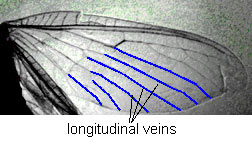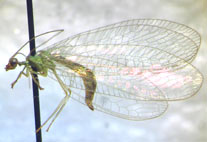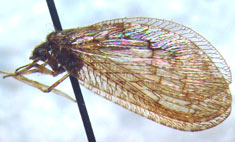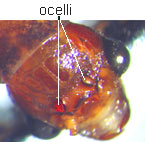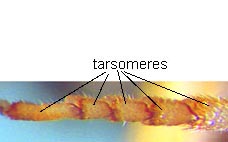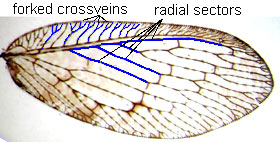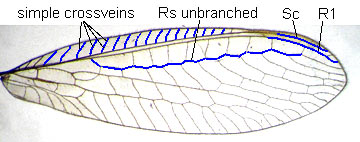| |
|
|
|
|
| 3(2') |
Antennae of 6 or more freely articulated segments, in some males very long and plumose; Rs 1-4 branched, if 3-branched, it is nearly always R2+3 that is forked; palps usually with 3-5 segments (suborder Nematocera) |
|
4 |
|
| 3' |
Antennae of 5 or fewwer (usually 3) segments, third segment sometimes annulated (appearing divided into subsegments, but not as distinct as the 3 main antennal segments), often bearing a terminal or dorsal style or arista, never long and plumose; Rs 2- or 3-branched (rarely unbranched), if 3-branched it is nearly always R4+5 that is forked; palps with not more than 2 segments (suborder Brachycera) |
|
31 |
|
| 4(3) |
Mesonotum with V-shaped suture; legs long and slender |
|
5 |
|
| 4' |
Mesonotum without V-shaped suture; legs variable |
|
8 |
|
| 5' |
Ocelli absent; V-shaped suture on mesonotum complete; 3A usually more than half as long as 2A and relatively straight, or absent |
|
6 |
|
| 6' |
R with 4 or fewer branches reaching wing margin; M3 cell without a crossvein; 3A present or absent |
|
7 |
|
| 7' |
Two anal veins reaching wing margin (3A present); R 2- to 4-branched, closed discal cell usually present; halteres without a process at base |
|
Tipulidae |
|
| 8' |
Wings not broad, venation not reduced, without a fanlike development of folds; antennae less than 3 times as long as body, not 6-segmented |
|
9 |
|
| 9' |
Ocelli absent |
|
22 |
|
| 22(9') |
C ending at or near wing tip |
|
23 |
|
| 22' |
C continuing around wing tip, though often weaker behind |
|
25 |
|
| 23(22) |
Wings broad, posterior veins weak; antennae about as long as head; dark-colored flies, rarely over 3 mm long, wit a somewhat humpbacked appearance |
|
Simuliidae |
|
| 23' |
Wings narrower and posterior veins stronger; antennae much longer than head; habitus usually not as in the preceding entry |
|
24 |
|
| 24' |
M unbranched; head flattened behind; metanotum generally with median furrow or keel; legs long, front legs usually the longest; pulvilli present or absent; anterior thoracic spiracle distinctly oval; mouthparts without mandibles, not fitted for piercing |
|
Chironomidae |
|
| 25' |
First tarsal segment longer than second, tarsi clearly 5-segmented; other characters variable |
|
26 |
|
| 26' |
Antennae at least twice as long as head, 2 basal segments neither thick nor globose; wings with 9-11 veins reaching wing margin |
|
27 |
|
| 27' |
Wings usually long and narrow, or if broad not pointed apically, and not densely hairy although scales may lie along the wing veins or wing margin; Rs with 3 or fewer branches, M 2-branched |
|
28 |
|
| 24' |
M unbranched; head flattened behind; metanotum generally with median furrow or keel; legs long, front legs usually the longest; pulvilli present or absent; anterior thoracic spiracle distinctly oval; mouthparts without mandibles, not fitted for piercing |
|
Chironomidae |
|
| 25' |
First tarsal segment longer than second, tarsi clearly 5-segmented; other characters variable |
|
26 |
|
| 26' |
Antennae at least twice as long as head, 2 basal segments neither thick nor globose; wings with 9-11 veins reaching wing margin |
|
27 |
|
| 27' |
Wings usually long and narrow, or if broad not pointed apically, and not densely hairy although scales may lie along the wing veins or wing margin; Rs with 3 or fewer branches, M 2-branched |
|
28 |
|
| 28(27') |
Proboscis long, extending far beyond clypeus; scles present on wing veins and wing margin, usually also on body |
|
Culicidae |
|
| 31(3') |
Empodia pulvilliform, tarsi with 3 pads |
|
32 |
|
| 31' |
Empodia bristlelike or absent, tarsi with not more than 2 pads |
|
44 |
|
| 32' |
Head more than half as wide as thorax; eyes never holoptic in female; calypteres usually small |
|
33 |
|
| 33' |
Venation normal, branches of Rs and M diverging to wing margin, branches of M ending well behind wing tip; middle and hind tibiae usually with apical spurs |
|
35 |
|
| 35(33') |
Third antennal segment annulated, or the antennae appearing to consist of more than 3 segments |
|
36 |
|
| 36(35) |
Postscutellum well developed; calypteres large and conspicuous; R4 and R5 divergen, enclosing the wing tip |
|
37 |
|
| 37(36) |
Both upper and lower calypteres large; first abdominal tergit with notch in middle of posterior margin and with median suture; anal cell closed; antennae usually arising below middle of head |
|
Tabanidae |
|
| 44' |
Coxae close together (ventral view); body usually not particularly flattened; not ectoparasitic |
|
46 |
|
| 46' |
Wings rounded at apex, almost always with crossveins beyond base of wing; antennae, size, shape, and color variable |
|
47 |
|
| 47(46') |
Rs 3-branched |
|
48 |
|
| 47' |
Rs 2-branched or unbranched |
|
55 |
|
| 48' |
M1 (or M1+2) ending behind wing tip; size and form variable |
|
50 |
|
| 50(48') |
Vertex sunken, top of head concave between compound eyes, eyes never holoptic |
|
Asilidae |
|
| 55' |
Second antennal segment not or scarcely longer than third, arista variable |
|
57 |
|
| 57(55') |
Anal cell elongate, longer than second basal cell, usually pointed apically, and narrowed or closed near wing margin; no frontal suture; head bristles usually lacking |
|
58 |
|
| 57' |
Anal cell usually shorter, closed some distance from wing margin, or lacking; if anal cell is elongate and pointed apically, then a frontal suture is present and head bristles are usually present |
|
62 |
|
| 58' |
Proboscis short; face narrow; without grooves below antennae; abdomen and R5 cell variable |
|
59 |
|
| 59(58') |
R5 cell closed; usually a spurious vein crossing r-m between R4+5 and M1+2 |
|
Syrphidae |
|
| 62' |
Frontal suture present |
|
65 |
|
| 65' |
Mouth opening normal, mouthparts present, functional; body usually with bristles; size, R5, M1+2 variable |
|
66 |
|
| 66(65') |
Second antennal segment with a longitudinal suture on outer side; thorax usually with a complete transverse suture; lower (innermost) calypter usually large (calyptrate muscoid flies, except Loxocera, family Psilidae) |
|
67 |
|
| 66' |
Second antennal segment without a longitudinal suture on outer side; thorax usually without complete transverse suture; lower calypter usually small or rudimentary (aclyptrate muscoid flies) |
|
76 |
|
| 67(66) |
Hypopleura and pteropleura with row of bristles; R5 cell narrowed or closed distally |
|
68 |
|
| 67' |
Hypopleura usually without bristles; if hypopleural bristles are present, than there are no pteropleural bristles, or proboscis is rigid and fitted for piercing, or R5 cell is not narrowed distally |
|
71 |
|
| 68(67) |
Postscutellum strongly developed; arista usually bare |
|
Tachinidae |
|
| 68' |
Postscutellum not developed or only weakly developed, if weakly developed (Rhinophoridae) upper half more or less membranous and concave in profile |
|
69 |
|
| 69' |
Postscutellum not at all developed; calypteres not narrow; M1+2 bending forward distally, but R5 cell narrowly open at wing margin |
|
70 |
|
| 70(69') |
Usually 2 (rarely 3) notopleural bristles, hindmost posthumeral bristle located laterad of presutural bristle; arista usually plumose beyond basal half; body often metallic, the thorax rarely or never with black stripes on a gray background |
|
Calliphoridae |
|
| 70' |
usually 4 notopleural brisles, and hindmost posthumeral bristle located even with or mesad of presutural bristle; arista generally plumose only in basal half; body not metallic, the thorax often with black stripes on a gray background |
|
Sarcophagidae |
|
| 72(71') |
Sixth vein (Cu2 + 2A) usually reaching wing margin, at least as a fold, or if not (some SCathophagidae) then lower calypter linear and R5 cell ot narrowed apically |
|
75 |
|
| 72' |
Sixth vein never reaching wing margin, even as a fold; R5 cell variable, but often narrowed apically |
|
73 |
|
| 73' |
Dorsal surface of hind tibia with only preapical bristle, usually near apex but sometimes near two thirds length of tibia; Cu2 + 2A, if extended, not meeting 3A |
|
74 |
|
| 74' |
Hind coxa either without setae on posterior surface, or if present, then Cu2 + 2A extending more than halfway to wing margin |
|
Muscidae |
|
| 75(72) |
Scutellum with fine, erect hairs on ventral surface, or if such hairs absent (Fucelliinae) then cruciate frontal bristles present; usually 2-4 sternopleural bristles |
|
Anthomyiidae |
|
| 76' |
Proboscis usually short and stout, rarely longer than head; second antennal segment usually shorter than first (if longer, then anal cell is shorter than second basal cell); anal cell usually very short or absent |
|
77 |
|
| 77' |
Sc inclomplete, not reaching C, often fusing with R1 distally; anal cell present or absent |
|
109 |
|
| 78(77) |
Ocelli present; size variable; wings with or without coloring |
|
80 |
|
| 80' |
Posterior thoracic spiracle without bristles; head usually not spherical, abdomen usually not elongate; palps usually well developed |
|
81 |
|
| 81' |
Dorsum of thorax convex, if rather flattened then legs are not bristly; widely distributed |
|
82 |
|
| 82' |
Eyes not prominently bulging and vertex not sunken; femora, size, color variable, but usually not as in preceding entry; widely distributed |
|
84 |
|
| 84' |
Oral vibrissae absent |
|
92 |
|
| 92(84') |
Sc apically bent forward at almost a 90-degree angle and usually ending before reaching C; C broken near end of Sc; wings usually patterned |
|
Tephritidae |
|
| 109 (77') |
Sc apically bent forward at olmost a 90-degree angle and ending before reaching C; C broken near end of Sc; anal cell usually with acute disal projection posteriorly; wings usually patterned |
|
Tephritidae |
|
| 109' |
Sc and anal cell not as in preceding entry; wing color variable |
|
138 |
|
| 138(109') |
Sternopleural bristle present; body not metallic; anal cell well develped, closed apically; widely distributed, common flies |
|
Drosophilidae |
|












